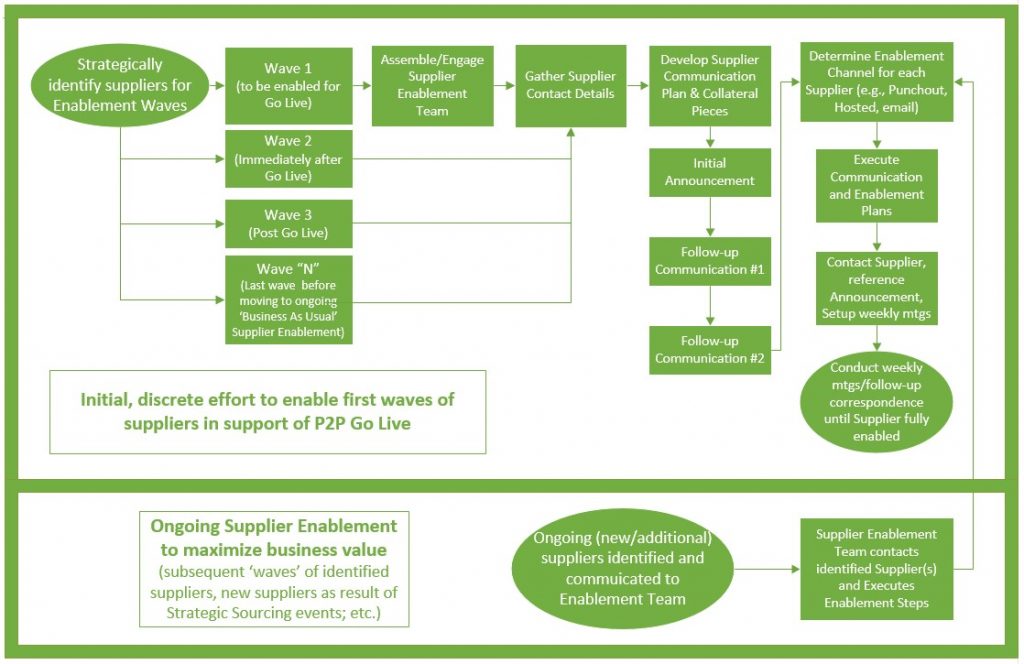Supplier Enablement: A Strategic Roadmap for Success
May 15, 2015
Supplier Enablement is a critical success factor for returning solid value on a Procure-to-Pay (P2P) investment. Along with Change Management initiatives to drive user adoption and compliance, Supplier Enablement is a key strategic ‘make or break’ activity by bringing most – if not all – spend under visibility as well as automating workflow and savings capture. Suppliers are incented to collaborate because the buying organizations’ users are directed through the P2P tool to buy from enabled suppliers – thereby reducing fragmented, maverick spend and so making the time and effort a ‘win/win’ for both parties.
To ensure long-term success, Supplier Enablement is best executed in three phases:
1. First, conduct strategic analysis to develop a prioritization, based on key stakeholder input and spend. The result of this exercise is the selection of a finite number of identified suppliers enabled in time for Go Live.
2. Next, secondary “waves” of suppliers are identified and enabled in the P2P tool to add full volume and maximize business value.
3. Finally, leverage the initial supplier segmentation in an ongoing, holistic development and execution of the overarching supplier management strategy.
Getting Started: Wave 1
As indicated above, begin with a discrete implementation effort focused on enabling a manageable number of suppliers (i.e., “Wave 1”) who have been selected for the initial P2P “Go-Live” launch, according to such business criteria as:
• Wide-ranging applicability across the organization (e.g., office supplies catalogs)
• Strategic value in streamlining and optimizing business processes, especially in managing approvals and item standards (e.g., IT hardware & software; mobile devices)
• Industry-specific and/or critical need and volume (e.g., providers of specialty products and services needed on a frequent, high-volume basis by the buying organization)
Adding Higher-Volume Suppliers
When the P2P tool is fully operational (i.e., electronic orders and invoices – with automated approval workflow – are being successfully managed through the defined channels), the next waves of suppliers to be enabled are typically the higher-volume ‘buckets‘ (often further grouped by category or buying business unit) to be enabled – at a minimum – to submit electronic invoicing to leverage automated workflow and effect large-scale, accurate cost allocation and account coding. Depending on the modules deployed and parameters set by the buying organization, the automation will facilitate a range of ‘contract-to-order-to-receipt-to-invoice’ matching to control price and item compliance. Supplier Enablement also insures adherence to agreed payment terms, facilitates cash flow management and optimizes invoice process costs*.
Increase Business Value through Ongoing Optimization
Once these initial tactical levers are in place and providing a solid ongoing base of spend data, the organization turns its focus to forward-looking, holistic strategy development to achieve its overall supplier management objectives. This phase will be comprised of deeper and periodic spend and category analyses, supplier segmentation and rationalization, and will serve as critical inputs to future waves of Supplier Enablement, planned strategic sourcing events, and category management plans. The result will be an ongoing, dynamic management of the supply base, including retiring some existing suppliers from time-to-time as well as onboarding new suppliers who bring additional value and innovation and with whom the cycle of Supplier Enablement outreach and education activities begin anew.
The following diagram depicts high-level Supplier Enablement activities:

The challenge some organizations face is the ability to effectively sustain the focus, resources and knowledge to support the ongoing but periodic nature of Supplier Enablement activities, without which total expected value of the P2P implementation and licensing investment will fall short. Supplier Enablement plans have to be developed and executed (including development and execution of a tailored supplier communication strategy). Planning and data gathering time is followed by introductory and educational supplier contact (to transmit specific information about setting up electronic transmission of orders and invoices), as well as sustained follow-up and progress tracking in order to thoroughly and successfully ‘make it happen.’ While the need for Supplier Enablement is ongoing in nature, there are often peaks and valleys in the volume of need at any one time, as well as competing priorities. These include:
• Activities tied to fiscal calendar, budget cycle and other annual milestones
• Number and type of contracts coming up for renewal/re-sourcing throughout the year
• Business plans and objectives (which impact strategic supply relationships)
These fluctuations in volume and priority can make it difficult to appropriately maintain and effectively leverage trained resources for Supplier Enablement activities on an as-needed basis.
To meet this challenge for managed Supplier Enablement services, some companies rely on their P2P providers and partners to bring the needed expertise and resources on a just-in-time, on-demand approach, thereby further optimizing the buying organization’s total cost of P2P ownership and furthering its success. If you would like to know more about how Shelby has helped organizations to achieve maximized business value with their strategic Supplier Enablement objectives, please contact info@theshelbygroup.com.
Laura Mahoney
Senior Manager
lmahoney@theshelbygroup.com
